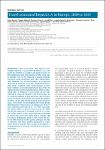Travel-associated hepatitis A in Europe, 2009 to 2015
Beauté, Julien
Westrell, Therese
Schmid, Daniela
Müller, Luise
Epstein, Jevgenia
Kontio, Mia
Couturier, Elisabeth
Faber, Mirko
Mellou, Kassiani
Borg, Maria-Louise
Friesema, Ingrid
Vold, Line
Severi, Ettore
Background: Travel to countries with high or intermediate
hepatitis A virus (HAV) endemicity is a risk
factor for infection in residents of countries with low
HAV endemicity. Aim: The objective of this study was
to estimate the risk for hepatitis A among European
travellers using surveillance and travel denominator
data. Methods: We retrieved hepatitis A surveillance
data from 13 European Union (EU)/ European Economic
Area (EEA) countries with comprehensive surveillance
systems and travel denominator data from the
Statistical Office of the European Union. A travel-associated
case of hepatitis A was defined as any case
reported as imported. Results: From 2009to2015, the
13 countries reported 18,839 confirmed cases of hepatitis
A, of which 5,233 (27.8%) were travel-associated.
Of these, 39.8% were among children younger than 15
years. The overall risk associated with travel abroad
decreased over the period at an annual rate of 3.7%
(95% confidence interval (CI): 0.7–2.7) from 0.70 cases
per million nights in 2009 to 0.51 in 2015. The highest
risk was observed in travellers to Africa (2.11 cases
per million nights). Cases more likely to be reported
as travel-associated were male and of younger age
(<25 years). Conclusion: Travel is still a major risk factor
for HAV infection in the EU/EEA, although the risk
of infection may have slightly decreased in recent
years. Children younger than 15 years accounted for a
large proportion of cases and should be prioritised for
vaccination.
Dateien zu dieser Publikation

